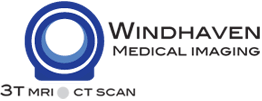Injection Procedures
Myelography/Arthography/Discography
Meylography
Myelography is an imaging examination that involves the introduction of a spinal needle into the spinal canal and the injection of contrast material in the space around the spinal cord (the subarachnoid space) and nerve roots using a real-time form of x-ray called fluoroscopy.
When the contrast material is injected into the subarachnoid space, the radiologist is able to view and evaluate the status of the spinal cord, nerve roots, and meninges, which are the membranes which surround and cover the spinal cord and nerve roots. Myelography provides a very detailed picture (myelogram) of the spinal cord and spinal column. The radiologist views the passage of contrast material in real-time within the subarachnoid space as it is flowing using fluoroscopy but also may take permanent images, called x-rays or radiographs, of the contrast material around the spinal cord and nerve roots in order to document abnormalities involving or affecting these structures. In most cases, the myelogram is followed by a computed tomography (CT) scan to better define the anatomy and any abnormalities.
Arthrography
Conventional arthrography is the x-ray examination of a joint that uses a special form of x-ray called fluoroscopy and a contrast material containing iodine. Some arthrography examinations also use magnetic resonance imaging (MRI). MR arthrography involves the injection of a contrast material into the joint, just like in conventional arthrography, except that the contrast material is different. As in conventional arthrography, the contrast material outlines the structures within the joint. This allows them to be evaluated by the radiologist to determine the anatomy of the joint.
Discography
A discogram is an enhanced X-ray examination of the intervertebral discs. Dye is injected into the center of the injured disc(s) making the disc clearly visible. This test is used to determine which disc has structural damage and whether it is causing pain. A discogram can show if a disc has begun to rupture and if it has tears in the tough outer ring (the annulus).



